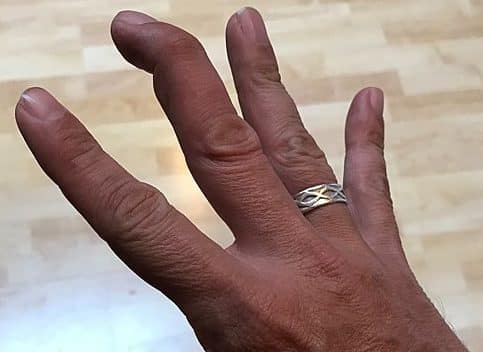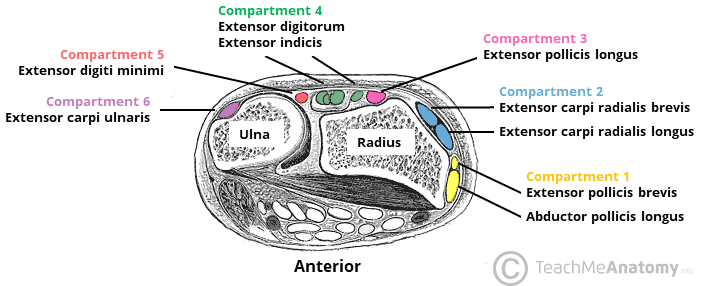Introduction
The extensor tendons of the hand act to extend the fingers at the metacarpophalangeal and interphalangeal joints.
Extensor tendon injuries are very common, owing to their superficial location on the dorsum of the hand and wrist. Inappropriate management of these injuries can result in permanent deformity and loss of function.
In this article, we shall look at the assessment and management of extensor tendon injuries.
Zones of Extensor Tendon Injury
The extensor tendons originate from muscles in the posterior compartment of the forearm (Fig. 1).
These tendons enter the hand via the posterior aspect of the wrist, where they are organised into six compartments, each lined internally by a synovial sheath and separated from one another by fibrous septa:
- Compartment 1: Extensor pollicis brevis (EPB), abductor pollicis longus (APL)
- Compartment 2: Extensor carpi radialis longus (ECRL) and brevis (ECRB)
- Compartment 3: Extensor pollicis longus (EPL)
- Compartment 4: Extensor indicis (EI) and Extensor digitorum communis (EDC)
- Compartment 5: Extensor digiti minimi (EDM)
- Compartment 6: Extensor carpi ulnaris (ECU)
In clinical practice, the location of extensor tendon injury is described by a series of zones. Accurate determination of the zone of injury is important, as it will inform management and subsequent rehabilitation.
There are eight zones for extensor tendons of the digits and four zones specific to the thumb*:
| Thumb | Digits |
|
|
*One easy way to remember the zones of extensor tendon injury: the zones with odd numbers all refer to injuries occurring at the level of a joint (Zone 1- DIPJ, Zone 3 – PIPJ, Zone 5 – MCPJ etc.)
Clinical Features
Extensor tendon injuries usually occur as a result of a traumatic injury to the hand, wrist, or forearm.
In any patient with a hand injury, it is first important to ascertain their hand dominance and occupation, as this may impact decisions regarding treatment. It is also useful to establish the place, time, and mechanism of injury.
On examination, the following should be assessed:
- Look – Site and size of wound, and any evidence of gross contamination
- Feel – Neurovascular assessment of the digit or limb*
- Move – Ability to extend at the joint(s) distal to injury
- Include Elson’s test (see below)
*When compared with flexor tendon injuries, extensor tendon injuries are less associated with injury to the digital neurovascular bundles (as they lie volar in the digit and are relatively well protected by the phalanges).
Elson’s Test
Elson’s test is a special test that is used to assess for injury to the central slip of the extensor tendon. It should be considered in Zone III-V injuries.
To perform the test, the patient’s hand is rested on a table and the PIPJ of the affected finger is flexed to 90 degrees over the side of the table. The patient is then asked to extend at the PIPJ whilst the clinician provides resistance at the middle phalanx
Elson’s test is positive if the patient has weak extension at the PIPJ in combination with hyperextension at the DIPJ. The lateral bands overcompensate by hyperextending the DIPJ due to central slip injury.
Investigations
The diagnosis of extensor tendon injury is typically made on clinical examination.
However, ultrasound imaging can be useful to confirm the diagnosis, particularly in cases of delayed presentation.
In addition, any patient with a traumatic injury to the hand should receive plain film radiographs in order to exclude fracture.
Management
Ensure to irrigate the wound, removing any gross contamination, and cover with a non-adhesive dressing. Prophylactic antibiotics and tetanus vaccine booster should also be prescribed. Remove any jewellery from the affected hand and elevate the hand in a high arm sling.
In certain cases, non-operative management of an extensor tendon injury is appropriate. These are often closed injuries (i.e. no overlying laceration), such as a closed stable Zone 1 extensor tendon injuries (termed a Mallet finger, FIg. 2), where the DIP joint is immobilised in extension for 4-6 weeks using a splint.

Figure 2 – A Mallet Finger to the right middle finger
Operative Management
Most patients with a suspected extensor tendon injury will require surgical exploration +/- tendon repair.
For patients with Zone 1, 3, or 5 injuries, it is vital to assess the integrity of the joint capsule intra-operatively. If breached, a prophylactic joint washout is typically performed to reduce the risk of infection
Repair of the extensor tendon is generally indicated if the laceration affects >50% of the tendon width. There are many different techniques for extensor tendon repair, which vary according to the zone of injury.
Following surgical repair of an extensor tendon, patients should be referred to the hand therapy team for rehabilitation.
Complications
The main complications of extensor tendon repair are re-rupture, developing adhesions, or sequalae of extensor tendon imbalance (such as a Swan Neck or Boutonniere deformity)
Key Points
- Extensor tendon injuries are very common, owing to their superficial location on the dorsum of the hand
- Location of extensor tendon injury is described by a series of zones, which helps to inform management and subsequent rehabilitation
- Diagnosis of extensor tendon injury is typically made on clinical examination
- Most patients with a suspected extensor tendon injury will require surgical exploration +/- tendon repair

